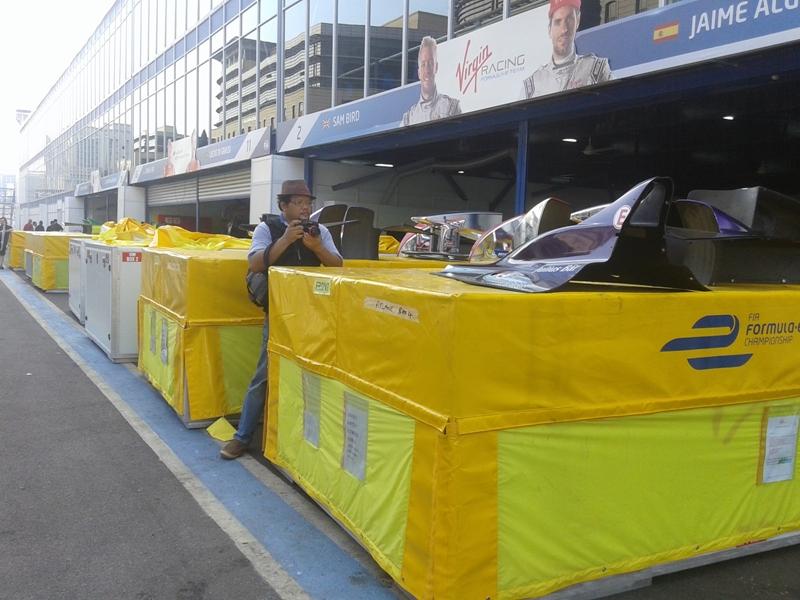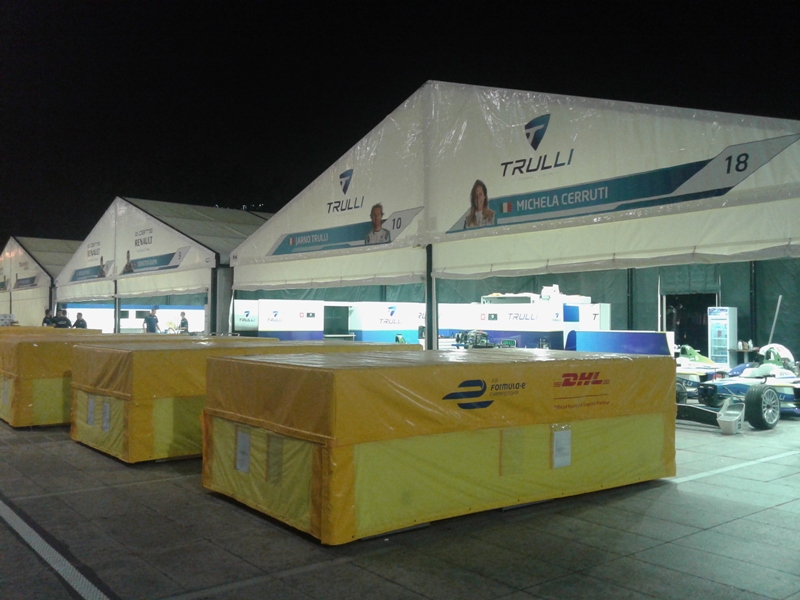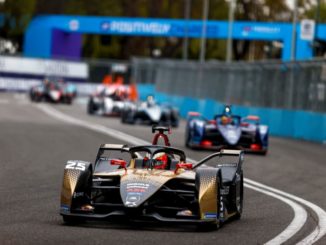La logistica della categoria mondiale di monoposto elettriche
Fonte: Formula E
Londra, Gran Bretagna. 3 dicembre 2014. Trasportare 40 auto da corsa della Formula E, le batterie agli ioni di litio ad alta sensibilità e tutte le attrezzature delle squadre di tutto il mondo in modo sicuro, e in tempo utile, è un’impresa enorme. Ma farlo nel modo più sostenibile possibile porta con sé anche nuove sfide.
La logistica è, ovviamente, fondamentale per qualsiasi serie internazionale di gare. Niente auto significa nessuna corsa, ma si tratta di un elemento che viene troppo spesso dato per scontato (fino a quando c’è un problema, ad esempio quando la nube di cenere dal vulcano Eyjafjallajokull in Islanda ha compromesso l’arrivo delle macchine di F1 per il Gran Premio di Spagna 2010).

Nel caso della Formula E, la logistica è ancora più cruciale in quanto, essendo un campionato sostenibile, è una delle aree più importanti per ridurre la propria impronta di carbonio, oltre ad essere un sistema fortemente monitorato da tutti.
Questo spiega in gran parte l’origine del calendario della stagione inaugurale della Formula E. I fan hanno spesso messo in discussione le lacune estese tra le gare, ma il ragionamento è sorprendentemente semplice; pause più lunghe consentono l’utilizzo di più mezzi efficienti per quanto riguarda le emissioni di carbonio e trasporti più lenti.
Altri campionati motoristici decidono il loro calendario e poi ci pensano a come arrivarci. Quello della Formula E è stato modellato in collaborazione con la logistica ufficiali ed il socio fondatore DHL. Lo specialista della logistica globale vanta oltre 30 anni di esperienza nel motorsport, tra cui F1, il World Touring Car Championship e il Campionato Mondiale Endurance.
“Abbiamo avuto il ‘cliente’ perfetto nella Formula E”, spiega il Deputy Motorsports DHL Pier Luigi Ferrari. “Ci hanno consultato fin dall’inizio e ci hanno coinvolti nella pianificazione del calendario delle gare. Questo ci ha permesso di fornire consigli, come ad esempio non saltellare tra i continenti e invece concentrare le gare in singole regioni per ridurre il numero complessivo di chilometri percorsi e per evitare anche il ritorno al quartier generale della Formula E a Donington Park tra le corse”.
L’obiettivo di utilizzare più mezzi efficienti con minor impronta di emissioni di carbonio significa che la barca o il treno è l’opzione preferita per il trasporto della famiglia circense della Formula E – composta da 450 tonnellate di automobili, batterie, ruote, attrezzature, strutture ricettive e gli attrezzi di gara dei piloti – che viaggeranno per oltre 52 mila km durante la stagione di nove città.
Comprensibilmente, a causa del tempo, e/o la distanza geografica, utilizzando solo barche e rotaia non è sempre possibile, il che significa che a volte le merci viaggiano via aerea.
“In questi casi cerchiamo sempre di utilizzare i tipi più efficienti di aerei ecologici, come i Boeing 747 o 777, che bruciano meno carburante per chilogrammo trasportato. Imballiamo anche il carico più strettamente possibile, al fine di garantire che gli aerei carichino il peso massimo”, dice Pier.
Per Pechino, questo è stato pari a circa due Boeing 747 e 25 container nell’oceano, con il 25% che ha viaggiato per ferrovia e su strada. L’impronta di carbonio totale è stata di circa 1.200 tonnellate, che, come tutte le corse, saranno compensate dalla Formula E alla fine della stagione.
“Il trasporto in Malesia ci ha permesso di utilizzare più oceano, piuttosto che il trasporto aereo e ridurre così l’impronta ancora più”, aggiunge Pier. “Il prossimo anno, in base alle insegnamenti di questo evento, ci aspettiamo che ci sarà anche in grado di fornire un risparmio ancora maggiore per la prima gara.
“Infatti, l’efficienza è la chiave. L’impatto maggiore si può avere sulla vostra impronta di carbonio è di essere più efficienti nel modo in cui le merci vengono spedite. Questo significa che il nostro primo obiettivo è quello di utilizzare le rotte più brevi e per consolidare tutto il carico, per quanto possibile, al fine di garantire che le «emissioni per chilometro tonnellata” siano le più basse possibile. Puntiamo anche nel modo di trasporto più efficiente, fino all’utilizzo di carrelli elevatori elettrici per il carico”.
Ma la pianificazione del calendario non è l’unico elemento di preoccupazione per DHL.
La necessità di trasporto del carico stesso sono tutt’altro che chiare.
“Le batterie al litio rappresentano una sfida unica per due motivi: in primo luogo, sono altamente infiammabili, il che significa che devono essere confezionate e gestite per il trasporto aereo in un modo particolare, e possono essere trasportate solo su aerei cargo. In secondo luogo, sono state le innovazioni che sono state create appositamente per la Formula E e che sono state basate su una tecnologia che è di proprietà intellettuale del produttore. Questo significa che avevano bisogno di essere certificate, in modo che possano essere trasportate e importate in ciascuno dei Paesi in cui le gare avrebbero avuto luogo. Abbiamo molta esperienza nel settore automobilistico e motoristico, quindi siamo stati in grado di affrontare entrambe le questioni in collaborazione con Formula E ed i produttori di batterie”.
E per quanto riguarda le prossime stagioni?
Non è un segreto che il CEO della Formula E Alejandro Agag prevede di aumentare il calendario a 16 o 18 gare con il tempo. Con meno tempo tra ogni ePrix, evitando di dover utilizzare l’aereo da trasporto può DHL ha ben presente che ci saranno ancora più ostacoli.
“Tutto dipende dove saranno queste gare e quanto ci sarà bisogno di viaggiare tra ogni gara. Impareremo ad ogni gara, però, in modo di esplorare tutte le opzioni disponibili, e anche si spera di integrare i veicoli più efficienti, come i carrelli elettrici, nel processo di trasporto. E ‘possibile che non ci sia in grado di evitare di volare per tutte le gare, ma useremo gli aeroplani da carico più efficienti disponibili per ogni percorso ogni volta che c’è bisogno di volare. E poi chi lo sa? Forse un giorno, qualcuno, ispirato dalla rivoluzione della Formula E, inventerà un aereo da carico elettrico!”
In English
How Formula E gets from A to B
Source: Formula E
London, United Kingdom. December 3, 2014. Transporting 40 Formula E race cars, highly sensitive lithium-ion batteries and all the teams’ equipment around the world safely, and on time, is a huge undertaking. But doing it in the most sustainable way possible brings with it even further challenges.
Logistics are, of course, fundamental to any international race series. No cars means no race, yet it’s an element that is all too often taken for granted (until there’s an issue such as when the ash cloud from Iceland’s Eyjafjallajokull volcano jeopardised the arrival of the F1 cars for the 2010 Spanish Grand Prix).

In Formula E’s case, logistics remain even more crucial as, being a sustainable championship, it’s one of the most important areas for reducing its carbon footprint, as well as one that is heavily scrutinised.
This largely explains how the inaugural Formula E calendar originated. Fans have often questioned the extended gaps in between races but the reasoning is surprising straightforward; longer breaks allow the use of slower, more carbon-efficient modes of transport.
Other motorsport championships decide their calendar and then workout how to get there. With Formula E it was fashioned in collaboration with official logistics and founding partner DHL. The global logistics specialist boasts more than 30 years’ experience in motorsports including F1, the World Touring Car Championship and the World Endurance Championship.
“We had the perfect ‘customer’ in Formula E”, explains DHL’s Deputy Motorsports MD Pier Luigi Ferrari. “They consulted us from the very beginning and involved us in planning the race calendar. This allowed us to provide advice, such as not hopping between continents and instead concentrating the races in individual regions to reduce the overall number of kilometres travelled, and to also avoid returning to the Formula E HQ in Donington Park between races.”
With the aim to use more carbon-efficient transport it means that boat or rail is the preferred option to transport the Formula E circus family – consisting of 450 tonnes of cars, batteries, wheels, equipment, hospitality structures and drivers’ race gear – more than 52,000km during the nine-city season.
Understandably, due to time, distance and/or geography, using just boats and rail is not always possible which means at times air freight has to be used.
“In these cases we always look to use the most efficient, ecologically friendly aircraft types such as Boeing 747s or 777s, which burn less fuel per kilogram carried. We also pack the cargo as tightly as we can, to ensure that those planes are carrying the maximum weight,” says Pier.
For Beijing, this was equivalent to around two Boeing 747 aircraft and 25 ocean containers, with 25% going by rail and road. The total carbon footprint was around 1,200 tons which, like all races, will be offset by Formula E at the end of the season.
“The transportation to Malaysia will allow us to use more ocean rather than air freight and reduce the footprint even more,” adds Pier. “Next year, based on the learnings from this event, we expect that we will also be able to deliver even greater savings for the first race.
“Indeed, efficiency is key. The biggest impact you can have on your carbon footprint is by being more efficient in the way that you ship goods. This means that our first aim is to use the shortest routes and to consolidate all the cargo as much as we can, to ensure that the ‘emissions per kilometre tonne’ are as low as possible. We also aim for the most efficient transport mode, right down to using electric forklifts for loading.”
But the calendar planning is not the only element of concern for DHL. The cargo itself is far from clear-cut.
“The lithium batteries pose a unique challenge themselves for two reasons: firstly, they are highly flammable, which means that they have to be packed and handled for air freight in a particular way, and they can only be transported on cargo aircraft. Secondly, they were new innovations that have been created specifically for Formula E and which were based on technology that was the intellectual property of the manufacturer. This meant that they needed to be certified, in order that they could be carried and imported to each of the countries where the races would take place. We have plenty of experience in automotive and motorsport, so we were able to address both issues jointly with Formula E and the battery manufacturers.”
And what about future seasons? It’s no secret that over time Formula E CEO Alejandro Agag plans to increase the calendar to 16 or 18 races. With less time between each ePrix, avoiding having to use air freight may well present DHL with even more obstacles.
“It all depends on where those races are and how far you need to travel between each race. We will learn with every race, however, to explore all the options we can, and also hopefully integrate more efficient vehicles, such as electric trucks, into the transportation process. It’s possible we may not be able to avoid flying for all races, but we will use the most efficient freighters available for each route whenever we do have to fly. And then who knows? Maybe one day, someone, inspired by Formula E’s electric revolution, will invent an electric cargo plane!”
no images were found



Be the first to comment